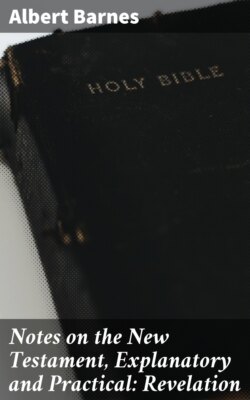Читать книгу Notes on the New Testament, Explanatory and Practical: Revelation - Albert 1798-1870 Barnes - Страница 9
На сайте Литреса книга снята с продажи.
§ III.—The Place where the Book was Written.
ОглавлениеTable of Contents
The book itself purports (chap. i. 9) to have been written in the island of Patmos, where the writer says he was “for the word of God, and for the testimony of Jesus Christ;” that is, clearly, where he had been banished for his attachment to the Saviour. For an account of this island, see Notes on chap. i. 9. The only question that has ever been raised on this point is, whether this was a reality, or a poetical fiction—that is, whether the writer in his visions merely seemed to have been transferred to the place, and this was made the imaginary scene of the vision. The latter supposition has been entertained by Eichhorn in his Introduction to the New Testament (1810), and by some other writers.
In favour, however, of understanding this as a literal fact, the following considerations may be suggested:—
1. The clear statement of the writer himself (chap. i. 9)—a statement that should be received as literally true, unless there is something in the character of the composition, or some intrinsic improbability in the case, to set it aside. If the composition were avowedly fictitious or poetical, then it would be understood that such a statement was not to be received literally. And thus, in a prophetic record, it might be clear that it was a mere visionary representation, in which the prophet seemed to be transported to some place where there would be no danger of misunderstanding it. Undoubtedly, on this principle, some of the visions of Ezekiel and Jeremiah are to be regarded as located at some place remote from that where the prophet was; and thus many of the visions in this book are located in heaven or elsewhere. But these cases are wholly different from the statement in chap. i. 9. Patmos is not represented as the mere scene of a vision. The statement occurs in a plain prose narrative, and there is no intrinsic improbability that it is true.
2. This accords with the representation of history, and with the probabilities of the case, that John was actually banished to Patmos in a time of persecution. See § II. On this point the representations of history are uniform, and they are such, that if a writer had designed to forge a book in the name of John, he would, in all probability, have fixed on Patmos as the scene of the vision, from the fact that he was actually banished there.
3. If Patmos was merely a fictitious place, why should John select it? What was there in that island that would have occurred to him as a proper place to be the scene of such visions? It was little known; it had no sacred associations; it had never been represented as a place visited by the Most High, and it had no particular relation to the scenes which are referred to. One born in Judea, and trained under the influence of the Hebrew religion; one who was a disciple of Christ, and who had witnessed the scene of the transfiguration or the ascension, would have been much more likely to select Sinai, Carmel, Hermon, Tabor, or Olivet, as the scene where the visions were to be laid. These were consecrated spots. On these God had manifested himself in a peculiar manner; had conversed with men, and had given glorious exhibitions of his character and plans. Why should not one of these spots—any one of them in itself is as well adapted to be the scene of such visions as the lonely isle of Patmos—have been selected? Why was a Grecian island chosen—a place not once named in all the sacred writings, and so small and so desolate as to have been almost entirely, before this, unknown even in the heathen world?
4. All the circumstances have the aspect of reality. It was a real persecution to which the writer refers, and it was a real affliction which he was experiencing, and the concinnity of the passage requires us to understand this as a real transfer to a lonely island. If that were a mere vision, then we should be required also to understand the statement that he was “a companion of others in tribulation” as a vision also, and his affliction as an account of an ideal transfer to that island. But this is contrary to the spirit of the passage in chap. i. 9; and the whole, therefore, should be understood as the statement of a literal fact.
These considerations are sufficient to show, that the common opinion, that the visions were seen in the island of Patmos, has every probability in its favour, and should be received as correct. Whether the record was actually made on that island, or was made afterwards, is a point on which no light can be observed, and which is of no importance. From such passages, however, as those in chap. x. 4; xiv. 13; xix. 9; and xxi. 5, it would seem probable that the record was made as soon as the visions were seen, and that the book was actually written in Patmos.
